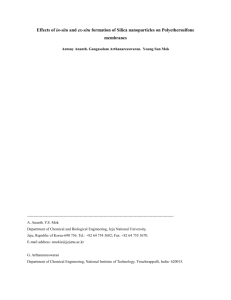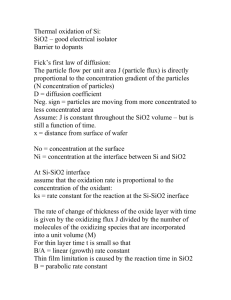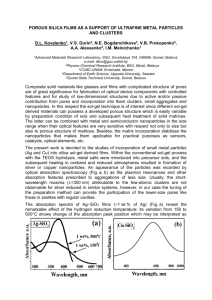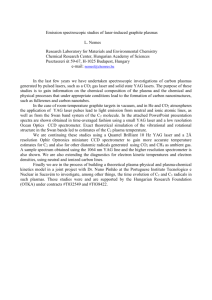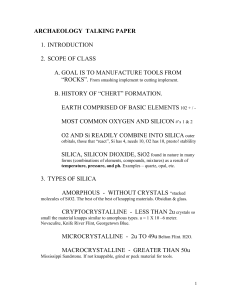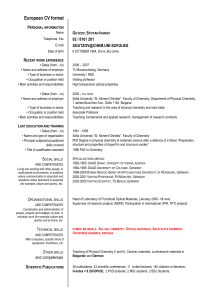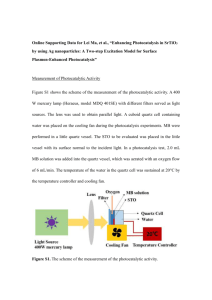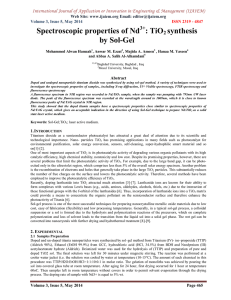International Journal of Application or Innovation in Engineering & Management... Web Site: www.ijaiem.org Email: Volume 3, Issue 5, May 2014
advertisement
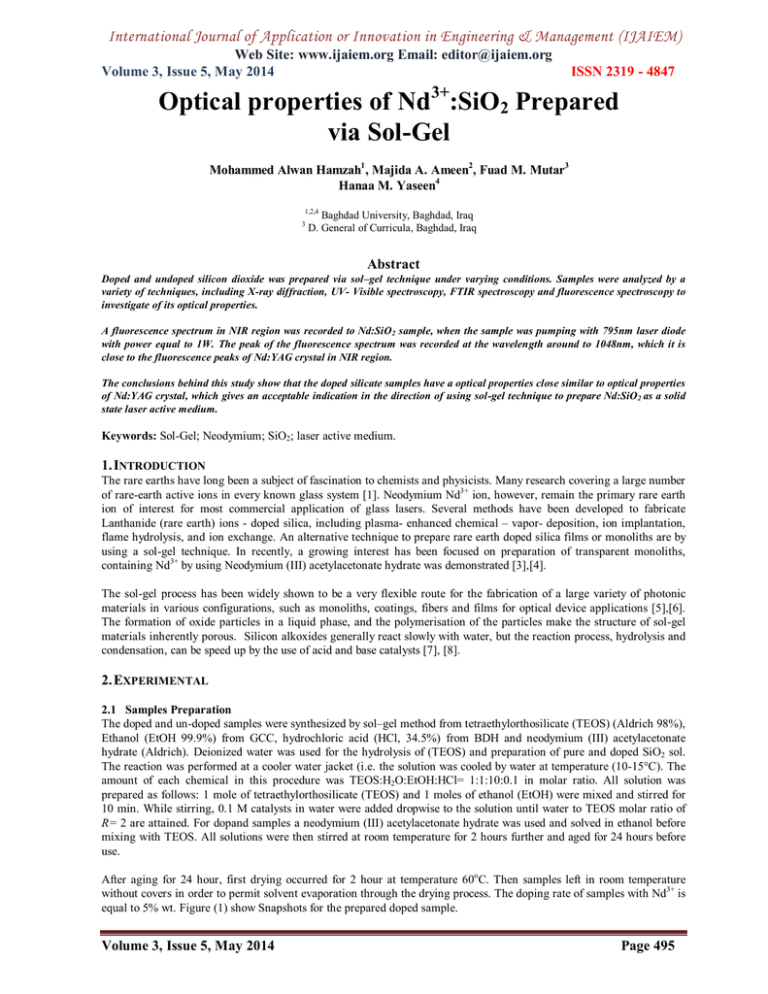
International Journal of Application or Innovation in Engineering & Management (IJAIEM) Web Site: www.ijaiem.org Email: editor@ijaiem.org Volume 3, Issue 5, May 2014 ISSN 2319 - 4847 Optical properties of Nd3+:SiO2 Prepared via Sol-Gel Mohammed Alwan Hamzah1 , Majida A. Ameen2, Fuad M. Mutar3 Hanaa M. Yaseen4 1,2,4 3 Baghdad University, Baghdad, Iraq D. General of Curricula, Baghdad, Iraq Abstract Doped and undoped silicon dioxide was prepared via sol–gel technique under varying conditions. Samples were analyzed by a variety of techniques, including X-ray diffraction, UV- Visible spectroscopy, FTIR spectroscopy and fluorescence spectroscopy to investigate of its optical properties. A fluorescence spectrum in NIR region was recorded to Nd:SiO2 sample, when the sample was pumping with 795nm laser diode with power equal to 1W. The peak of the fluorescence spectrum was recorded at the wavelength around to 1048nm, which it is close to the fluorescence peaks of Nd:YAG crystal in NIR region. The conclusions behind this study show that the doped silicate samples have a optical properties close similar to optical properties of Nd:YAG crystal, which gives an acceptable indication in the direction of using sol-gel technique to prepare Nd:SiO2 as a solid state laser active medium. Keywords: Sol-Gel; Neodymium; SiO2; laser active medium. 1. INTRODUCTION The rare earths have long been a subject of fascination to chemists and physicists. Many research covering a large number of rare-earth active ions in every known glass system [1]. Neodymium Nd3+ ion, however, remain the primary rare earth ion of interest for most commercial application of glass lasers. Several methods have been developed to fabricate Lanthanide (rare earth) ions - doped silica, including plasma- enhanced chemical – vapor- deposition, ion implantation, flame hydrolysis, and ion exchange. An alternative technique to prepare rare earth doped silica films or monoliths are by using a sol-gel technique. In recently, a growing interest has been focused on preparation of transparent monoliths, containing Nd3+ by using Neodymium (III) acetylacetonate hydrate was demonstrated [3],[4]. The sol-gel process has been widely shown to be a very flexible route for the fabrication of a large variety of photonic materials in various configurations, such as monoliths, coatings, fibers and films for optical device applications [5],[6]. The formation of oxide particles in a liquid phase, and the polymerisation of the particles make the structure of sol-gel materials inherently porous. Silicon alkoxides generally react slowly with water, but the reaction process, hydrolysis and condensation, can be speed up by the use of acid and base catalysts [7], [8]. 2. EXPERIMENTAL 2.1 Samples Preparation The doped and un-doped samples were synthesized by sol–gel method from tetraethylorthosilicate (TEOS) (Aldrich 98%), Ethanol (EtOH 99.9%) from GCC, hydrochloric acid (HCl, 34.5%) from BDH and neodymium (III) acetylacetonate hydrate (Aldrich). Deionized water was used for the hydrolysis of (TEOS) and preparation of pure and doped SiO2 sol. The reaction was performed at a cooler water jacket (i.e. the solution was cooled by water at temperature (10-15°C). The amount of each chemical in this procedure was TEOS:H2O:EtOH:HCl= 1:1:10:0.1 in molar ratio. All solution was prepared as follows: 1 mole of tetraethylorthosilicate (TEOS) and 1 moles of ethanol (EtOH) were mixed and stirred for 10 min. While stirring, 0.1 M catalysts in water were added dropwise to the solution until water to TEOS molar ratio of R= 2 are attained. For dopand samples a neodymium (III) acetylacetonate hydrate was used and solved in ethanol before mixing with TEOS. All solutions were then stirred at room temperature for 2 hours further and aged for 24 hours before use. After aging for 24 hour, first drying occurred for 2 hour at temperature 60o C. Then samples left in room temperature without covers in order to permit solvent evaporation through the drying process. The doping rate of samples with Nd3+ is equal to 5% wt. Figure (1) show Snapshots for the prepared doped sample. Volume 3, Issue 5, May 2014 Page 495 International Journal of Application or Innovation in Engineering & Management (IJAIEM) Web Site: www.ijaiem.org Email: editor@ijaiem.org Volume 3, Issue 5, May 2014 ISSN 2319 - 4847 Figure 1: Snapshot for some prepared doped sample. 2.2 Samples characterization Structural characterizations of the doped and un-doped SiO2 samples were done by X-ray diffraction (XRD). θ–2θ scans were recorded using ITAL-STRUCTURE diffractometer equipped. While Mid-IR spectra were obtained for the prepared samples using FT-IR spectrometer, Shimadzu, on KBr pellets of the samples. Absorption spectra were measured at room temperature with TupCen UV-VIS Spectrometer. Emission spectra were measured at room temperature by using SolarLab mono chromatore. As excitation source we used the 795nm 1W Laser diode. Furthermore absorption and emission spectra were measured for Nd:YAG crystal to obtain a standard measurements. 3. RESULT AND DISCUSSION The doped and undoped prepared samples have amorphous structure and x-ray data show no detectable peaks, as shown in Figure (2) [12]. Fourier transform infrared (FTIR) absorption spectra in the range of 4000–400 cm-1 were taken. The FTIR spectrum of doped and un-doped samples was illustrated in Figure (3). The characteristics vibrational bands of silica were found in the FTIR spectra. Where; the absorption bands at about 472 cm-1, 808 cm-1 and 1100 cm-1 which were due to bending, symmetric stretching and asymmetric stretching vibrations of Si-O-Si groups respectively. The band at around 960 cm-1 which is ascribed to stretching vibration of silanol (Si-OH) groups [9], [10], indicates the limited number of these groups in the silica network [9]. For dopant sample the bands around 960cm-1 is a weak which means that the condensation reaction is nearly complete more than from condensation reaction of pure sample. Another two bands were appeared at around 1600 cm-1and 3400 cm-1. These two bands were the characteristics vibration of O-H bond in water molecules [11], and indicating that the drying process at 60ºC dose not completely trap the water molecules from the pores of silica Xerogel network. Therefore, the sample needs heating at temperatures higher than 500 ºC to obtain sol-gel silica glass [12]. UV/Vis absorption spectra, at room temperature, of Nd3+ doped monoliths are presented in Figure (4). The spectrum of Nd:YAG is given for comparison. The enhanced absorption properties were mainly determined by the energy level structure of rare earth. The absorption spectrum of rare earth ions was due to electronic transitions caused by the energy level. For the Nd:YAG, the absorption bands in the range of 500–850 nm corresponded to the energy level transition of 4 I9/2 →2G9/2 (513 nm), 4 I9/2 →4G7/2 (530nm), 4I9/2→4G5/2 (588nm), 4I9/2→ 4 F9/2 (680nm), 4I9/2→(4F7/2 , 4S3/2) (735nm, 747nm) and 4 I9/2 →(4F5/2, 2H9/2) (795, 807nm), respectively[13]-[15]. For the Nd3+:SiO2, the absorption bands in the range of 500–850 nm corresponded to the energy level transition of 4 I9/2 →2G9/2 (509nm), 4 I9/2 →4G7/2 (518nm), 4I9/2→4G5/2 (580nm), 4I9/2→ 4F9/2 (680nm), 4I9/2→4F7/2 (747nm) and 4 I9/2 →4F5/2 (797nm)[16],[17]. Figure 2 XRD spectra for prepared samples, (a) SiO2; (b) Nd:SiO2 Volume 3, Issue 5, May 2014 Page 496 International Journal of Application or Innovation in Engineering & Management (IJAIEM) Web Site: www.ijaiem.org Email: editor@ijaiem.org Volume 3, Issue 5, May 2014 ISSN 2319 - 4847 By comparison between two absorption spectra, it can noted that some peaks of silica dopant sample are mismatching with the peaks of Nd:YAG. That’s main the silica medium affect on the energy level of Nd3+ and forced the energy level to divided into a sublevel difference from known sublevel of Nd:YAG. It’s clearly seen that the absorption peaks band width of ND:SiO2 are widely while ND:YAG have a narrow absorption peaks. That’s because of amorphous structure of SiO2 . The important result from the absorption spectra is that the silica dopant sample could be optically pumped in similar way of Nd:YAG optical pumping. Figure 3 FTIR spectra for samples, (a) SiO2 doped with 5%wt Nd+3; (b) Pure SiO2. An important performance indicator for the sample to be useful for glass laser applications is its fluorescence properties. To determine the optical characteristics of the samples, photoluminescence measurements were carried out using the 795nm Laser Diode for excitation. The obtained spectrum is shown in Figure (5) for both of Nd:SiO2 and Nd:YAG crystal. From Nd:YAG fluorescence spectrum it could observed a weak and broad peak around 1065nm with band width of 11nm at full width half maximum (FWHM). While the Nd:SiO2 fluorescence spectrum have a weak and broad peak at around 1047nm with band width of 18nm at FWHM. These two peaks correspond to the transition between the levels 4 F3/2 -4I11/2 of Nd3+ ion [13]-[17]. Figure 4 Absorption spectra for, (a) SiO2 doped with 5%wt Nd+3; (b) Nd:YAG Crystal. Absorption spectra are fundamental to determine the factors governing several optical properties, such as absorption coefficients α(λ), absorption cross-sections σ(λ), and refractive index n(λ). σ(λ) can be calculated from the absorption spectra of Nd3+:YAG and ND3+:SiO2 sample using the formula[12]: σ (λ) = α (λ) /ρ -----(1) Where ρ is the ion density (cm-3). Bowen and Wokes [18] gave empirical formula to get a sufficient accurate value of radiative lifetime τrad (in seconds): 1/τrad = 2900 n2 ύ2 ∫ε(ύ)dύ ------(2) Where n is the refractive index of the material, ύ is the wavenumber at the peak of absorption band in µm-1 and ∫ε(ύ)dύ is the area under the absorption band curve. ε(ύ) is molecular extincation coefficient [18]. The radiative lifetime τrad calculated by eq. (2) refers to the spontaneous emission of light, and corresponds to the probability Anm (=1/τrad), that a Volume 3, Issue 5, May 2014 Page 497 International Journal of Application or Innovation in Engineering & Management (IJAIEM) Web Site: www.ijaiem.org Email: editor@ijaiem.org Volume 3, Issue 5, May 2014 ISSN 2319 - 4847 molecule will undergo a radiative transition from an upper state n, to a lower state m, in the absence of radiation of frequency ν [18]. Peak emission cross-section (σp ) for lasing transition 4F3/2 -4 I11/2 can be determined from the relation [12], [19]: σp = λp 4 / 8 π c ń2 Δλeff. τrad. -------- (3) where λp is the peak wavelength within the fluorescence band, Δλeff is the fluorescence linewidth (effective); which determined by the full width half maximum (FWHM) of the fluorescence band and ń is given by: ń = [n2(λ) +2]2 / 9n(λ).-------- (4) Table (1) present some results of measured and calculated parameters for Nd:YAG and Nd:SiO2 samples. The parameters calculated to absorption band 4I9/2→4F5/2 and to fluorescence peak correspond to the transition 4F3/2 -4I11/2 of Nd3+ ion. The measured and calculated parameters to Nd:YAG are close to known parameters of Nd:YAG crystal [13-15]. That’s gives a good indication about the accuracy of parameters measurements to doped silica. From table (1), it can see that Nd:SiO2 parameters are somewhat close to parameters of Nd:YAG. That’s means the optical properties to prepared doped sample are close similar to optical properties of Nd:YAG crystal. This result gives further more good indication in direction of using Sol-Gel technique to prepare of Nd:SiO2 samples as solid state Laser active medium. Table 1 : Optical properties parameters for Nd:YAG and Nd:SiO2 sample. Parameters absorption cross-sections σ(λ), (cm2) Radiative lifetime τrad ,(mS) Emission Peak wavelength (nm) Linewidth FWHM (nm) Emission Cross section (×10−19 cm2) Nd:YAG 7.2*10-19 510 1063 11 6.7 Nd:SiO2 2.1*10-19 230 1048 18 1.45 Figure 5: fluorescence spectra for, (a) SiO2 doped with 5%wt Nd+3; Nd:YAG Crystal. 4. CONCLUSION The sol-gel glass of Nd3+ doped silica is successfully prepared via sol-gel technique. Due to the suitable sol-gel parameters; the silica samples have transparent. The doped and undoped prepared silica samples have amorphous structures. The optical properties of doped samples are close similar to the optical properties of Nd:YAG crystal. This suggests that it could use sol-gel technique to prepare of Nd:SiO2 as solid state Laser active medium. References [1] Brian G. Wybourne, “The fascination of the rare earths—then, now and in the future”, Journal of Alloys and Compounds (2004), 380(1), pp96-100. [2] Mohammed. A. H. , Fawaz N. Saiof and Adnan. S. A., “Prepared of Nd:TiO2 via Sol-Gel technique”, International Journal of Application or Innovation in Engineering & Management, Vol. 2, pp 432-437, (2013). [3] Fawaz N. Saiof and Mohammed. A. H., “Prepared of Nd: TiO2 Nano Particles Powder as IR Filter via Sol-Gel” Advances in Materials Physics and Chemistry, 3, 174-177, (2013). Volume 3, Issue 5, May 2014 Page 498 International Journal of Application or Innovation in Engineering & Management (IJAIEM) Web Site: www.ijaiem.org Email: editor@ijaiem.org Volume 3, Issue 5, May 2014 ISSN 2319 - 4847 [4] Adnan S., Fadhil A. R., Majida A. A.,”TiO2 nanoparticles prepared by sol-gel”, Journal of Materials Science and Engineering, Dec., Volume 3, No.12 p81-84, (2009). [5] Baha T. C., Wesam A. A. and Firas J. M., “Synthesis of Nanosilica Glass Activated by Erbium Ions, Spectroscopic studies”, Iraqi Journal of Physics, Vol. 7, No.8, PP. 85 – 92, (2009). [6] Baha T. C., Firas J. M., Wesam A. A. and M. A. Hameed, “Study the spectroscopy of samarium encapsulated in silica Xerogel matrices“, Iraqi Journal of Physics, Vol. 9, No.15, PP. 49-54, (2011). [7] Wesam A. A., Firas J. M., Baha T. C.,” Study of R -molar ratio effect on the transformation of tetraethylorthosilicat precursor to gels in sol-gel technique”, Baghdad Science Journal Vol.6(3) PP. 590-595., (2009) [8] Wesam A. A. Twej, “TEMPERATURE INFLUENCE ON THE GELATION PROCESS OF TETRAETHYLORTHOSILICATE USING SOL-GEL TECHNIQUE”, Iraqi Journal of Science, Vol.50, No.1, PP. 43 - 49, (2009) [9] Yang L., Fabrication and characterization of microlasers by sol-gel method, PhD. Thesis, California Institute of Technology, pp. 43-47, (2005). [10] Muralidaran M. N., Rasmitha C. A. and Ratheesh R., Photoluminescence and FTIR studies of pure and rare earth doped silica Xerogel and Aerogel, J. of Porous materials, vol. 16, pp. 635-640, (2009). [11] Carla C., Mariano C., Roberta L. and Ama M., Eu3+-doped Y2O3-SiO2 nanocomposite obtained by a sol-gel method, Mat. Res. Soc. Symp. Proc., vol. 676, pp. 181-186, (2001). [12] Firas J. K., “PREPARATION AND STUDY OF RARE EARTH LASER ACTIVE MEDIA USING SOL-GEL TECHNIQUE”, Ph. D. thesis, Baghdad University , (2009). [13] W. Koechner, "Solid State Laser Engineering", Springer Series in Optical Sciences, Vol.1, 5th ed., New York, (1999). [14] D. K. Sardar, D. M. Dee, K. L. Nash, R. M. Yow, and J. B. Gruber, “Optical absorption intensity analysis and emission cross sections for the intermanifold and the inter-Stark transitions of Nd3+(4f 3) in polycrystalline ceramic Y2O3,” J. Appl. Phys. 100(12), 123106 (2006). [15] Marvin J. Weber Ph.D. , “Handbook of Lasers” , CRC Press (2001) LLC. [16] CHEN Jiao et al., ”Preparation and properties of Nd:YAG ultra-fine powders”, JOURNAL OF RARE EARTHS, Vol. 29, No. 1, p. 44, 2011. [17] D.C.Brown, "High – Peak Power Nd: Glass Laser System", Springer Series in Optical Sciences, vol.25, New York, 1981. [18] C. A. Parker, "Photoluminescence of Solutions", Elsevier, Amsterdam, pp. 25-27, (1968). [19] Hongxu Zhou, Qivhong Yang , J.Xu,H.Zhang, "Preparation and Spectroscopic Properties of 2% Nd:(Y0.9 La0.1)O3 Transparent Ceramics" J.Alloys comped .,vol.471,pp.474-476. 2009. AUTHOR Mohammed Alwan Hamzah received the B.Sc. and M.Sc. degrees in Physics from Baghdad Uni. (Iraq) in 1986 and 1999, respectively. During 1996-1999, he stayed in college of science to study Optoelectronics, Laser and Digital Image processing. In 2014 he received the Ph.D. degree from Mosul University, (Iraq). He works now at the college of science, Baghdad University. Volume 3, Issue 5, May 2014 Page 499
